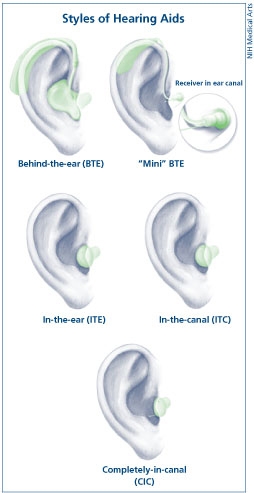Hearing Aid Styles
There are three basic styles of hearing aids. The styles differ by size, their placement on or inside the ear, and the degree to which they amplify sound.

- Behind-the-ear: Let’s talk about those hearing aids you might see folks wearing behind their ears – the trusty Behind-the-Ear (BTE) ones. They’re like little helpers tucked snugly behind the ear, with a plastic earmold cozying up inside the outer ear. All the electronic wizardry happens in that little case, beaming sound waves through the earmold and straight into the ear. These BTE aids are popular among folks of all ages dealing with anything from mild to profound hearing loss.
Now, there’s a new version of these BTE aids on the block – the open-fit, receiver in the canal (RIC) hearing aid. They’re smaller and slicker, fitting neatly behind the ear, with just a tiny wire sneaking into the ear canal. And here’s the beauty of it: that open design keeps your ear canal feeling airy and fresh. Plus, if you’re someone who battles with earwax buildup, these might just become your new best friend. They’re less likely to get clogged up, keeping your hearing clear as a bell. Oh, and no more feeling like your voice is trapped in a box – with the open-fit design, your voice sounds as natural as can be.
So, whether you’re sticking with the classic BTE or ready to try out the sleek RIC, there’s a hearing aid out there to suit your style and keep you tuned in to all life’s conversations!
- In-the-ear (ITE) hearing aids fit completely inside the outer ear and are used for mild to severe hearing loss. The case holding the electronic components is made of hard plastic. Some ITE aids may have certain added features installed, such as a telecoil, a small magnetic coil that makes it easier to hear conversations over the telephone. ITE aids usually are not worn by young children because the casings need to be replaced often as the ear grows.
- Canal aids fit into the ear canal and are available in two styles. The in-the-canal (ITC) hearing aid is made to fit the size and shape of a person’s ear canal. A completely-in-canal (CIC) hearing aid is nearly hidden in the ear canal. Both types are used for mild to moderately severe hearing loss.
Because they are small, canal aids may be difficult for a person to adjust and remove. In addition, canal aids have less space available for batteries and additional devices, such as a telecoil. They usually are not recommended for young children or for people with severe to profound hearing loss because their reduced size limits their power and volume.
Hearing aids work differently depending on the electronics used. Analog electronics was the former type used however most manufacturers have phased out analog aids. The newer digital aids now offer better clarity and more fine-tuning ability than the older analog aids.
Digital aids convert sound waves into numerical codes, similar to the binary code of a computer, before amplifying them. Because the code also includes information about a sound’s pitch or loudness, the aid can be specially programmed to amplify some frequencies more than others. Digital circuitry gives an audiologist more flexibility in adjusting the aid to a user’s needs and to certain listening environments. These aids also can be programmed to focus on sounds coming from a specific direction. Digital circuitry can be used in all types of hearing aids.
